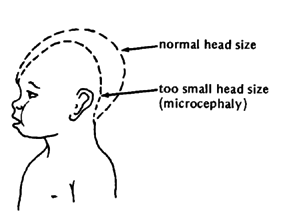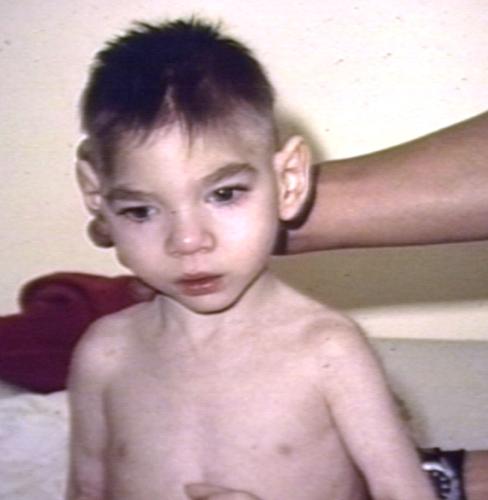Microcephaly: Difference between revisions
No edit summary |
No edit summary |
||
| Line 152: | Line 152: | ||
[[Category:Signs and symptoms]] | [[Category:Signs and symptoms]] | ||
[[Category:Pediatrics]] | [[Category:Pediatrics]] | ||
[[Category:FLK]] | |||
[[ar:جمجمة صغيرة]] | [[ar:جمجمة صغيرة]] | ||
Revision as of 14:30, 30 July 2012
Template:DiseaseDisorder infobox
|
WikiDoc Resources for Microcephaly |
|
Articles |
|---|
|
Most recent articles on Microcephaly Most cited articles on Microcephaly |
|
Media |
|
Powerpoint slides on Microcephaly |
|
Evidence Based Medicine |
|
Clinical Trials |
|
Ongoing Trials on Microcephaly at Clinical Trials.gov Clinical Trials on Microcephaly at Google
|
|
Guidelines / Policies / Govt |
|
US National Guidelines Clearinghouse on Microcephaly
|
|
Books |
|
News |
|
Commentary |
|
Definitions |
|
Patient Resources / Community |
|
Patient resources on Microcephaly Discussion groups on Microcephaly Patient Handouts on Microcephaly Directions to Hospitals Treating Microcephaly Risk calculators and risk factors for Microcephaly
|
|
Healthcare Provider Resources |
|
Causes & Risk Factors for Microcephaly |
|
Continuing Medical Education (CME) |
|
International |
|
|
|
Business |
|
Experimental / Informatics |
Editor-In-Chief: C. Michael Gibson, M.S., M.D. [1]
Overview
Microcephaly is a neurological disorder in which the circumference of the head is at least three standard deviations smaller than average for the person's age and sex. Microcephaly may be congenital or it may develop in the first few years of life.
Pathophysiology
The disorder may stem from a wide variety of conditions that cause abnormal growth of the brain, or from syndromes associated with chromosomal abnormalities. Two copies of a loss-of-function mutation in one of the microcephalin genes causes primary microcephaly.
Natural History, Complications, Prognosis
Microcephaly may be congenital or it may develop in the first few years of life. Infants with microcephaly are born with either a normal or reduced head size. Subsequently the head fails to grow while the face continues to develop at a normal rate, producing a child with a small head and a receding forehead, and a loose, often wrinkled scalp. As the child grows older, the smallness of the skull becomes more obvious, although the entire body also is often underweight and dwarfed. Development of motor functions and speech may be delayed. Hyperactivity and mental retardation are common occurrences, although the degree of each varies. Convulsions may also occur. Motor ability varies, ranging from clumsiness in some to spastic quadriplegia in others. Some children will only have mild disability. Others, especially if they are otherwise growing and developing normally, will have normal intelligence and continue to develop and meet regular age-appropriate milestones.
Prognosis
In general, life expectancy for individuals with microcephaly is reduced. The prognosis varies depending on the presence of associated abnormalities.
Pathophysiology
Microcephaly is a disorder characterized by a small brain and may be caused by a disturbance in the proliferation of nerve cells. Microcephaly may also be associated with maternal problems such as alcoholism (which can result in the Fetal alcohol syndrome disability), diabetes, or rubella (German measles). A genetic factor may play a role in causing some cases of microcephaly. Affected newborns generally have striking neurological defects and seizures. Severely impaired intellectual development is common, but disturbances in motor functions may not appear until later in life.
Causes
Common Causes
- Anencephaly
- Cerebral atrophy; perinatal brain damage from hypoxia
- Congenital transplacental infection
- Craniosynostosis (total)
- Encephalocele
- Micrencephaly (idiopathic small brain)
Uncommon Causes
- Aminopterin fetopathy
- Aspartylglucosaminuria
- Beckwith-Wiedemann syndrome
- Børjeson-Forssman-Lehman syndrome
- Brachmann-de Lange syndrome (de Lange syndrome)
- Cephaloskeletal dysplasia (Taybi-Linder syndrome)
- Cerebro-oculo-facio-skeletal syndrome (Pena–Shokein syndrome type II)
- Chondrodysplasia punctata (rhizomelic type)
- Christian syndrome (adducted thumbs syndrome)
- Chromosome syndromes
- 4: del 4p syndrome (Wolf-Hirschhorn syndrome)
- 5: del 5p syndrome (cat cry syndrome, cri du chat syndrome)
- 7: del 7q syndrome
- 9: dup 9p syndrome
- 18: del 18q syndrome
- Cockayne syndrome
- Coffin-Siris syndrome
- Cohen syndrome
- Cutis verticis gyrata
- Deprivation dwarfism (pyschosocial dwarfism)
- Dubowitz syndrome
- Dyggve-Melchior-Clausen dysplasia (Smith–McCort syndrome)
- Familial microcephaly
- Fanconi anemia (pancytopenia-dysmelia syndrome)
- Fetal alcohol syndrome
- Fetal hydantoin syndrome (Dilantin embryopathy)
- Fetal trimethadione syndrome
- Fraser syndrome (cryptophthalmia syndrome)
- Freeman-Sheldon syndrome (whistling face syndrome)
- Galloway-Mowat syndrome
- Goltz syndrome (focal dermal hypoplasia)
- Happy puppet syndrome (Angelman syndrome)
- Holoprosencephaly
- Arrhinencephaly
- Homocystinuria
- Incontinentia pigmenti
- Johanson-Blizzard syndrome
- Juberg-Hayward syndrome
- Kearns-Sayre syndrome
- Krabbe disease (globoid cell leukodystrophy)
- Lenz microphthalmia syndrome
- Lesch-Nyhan syndrome
- Lissencephaly syndromes (congenital agyria)
- Lowry-Wood syndrome
- Marden-Walker syndrome
- Marinesco-Sjögren syndrome
- Maternal phenylketonuria
- Meckel syndrome
- Menkes syndrome (kinky-hair syndrome)
- Microcephalic osteodysplastic dysplasia
- Microcephaly-lymphedema syndrome
- Noonan syndrome
- Normal variant
- Oculo-auriculo-vertebral spectrum (Goldenhar-Gorlin syndrome)
- Opitz trigonocephaly syndrome (C syndrome)
- Prader-Willi syndrome
- Prenatal radiation
- Riley-Day syndrome (familial dysautonomia)
- Rubinstein-Taybi syndrome
- Seckel syndrome (bird-headed dwarfism)
- Smith-Lemli-Opitz syndrome
- Trichorhinophalangeal dysplasia, type II (Langer-Giedion syndrome) and III (Ruvalcaba syndrome)
- Trisomy 9 syndrome
- Trisomy 13 syndrome
- Trisomy 18 syndrome
- Trisomy 21 syndrome (Down syndrome)
- Trisomy 22 syndrome
- XXXXX syndrome
Diagnosis
Physical Examination
Head
THe circumference of the head is smaller than 3 standard deviations below that of age sex matched individuals.
Treatment
Generally there is no specific treatment for microcephaly. Treatment is symptomatic and supportive.
See Also
External links
Template:Congenital malformations and deformations of nervous system
ar:جمجمة صغيرة cs:Mikrocefalie de:Mikrozephalie sv:Mikrocefali

